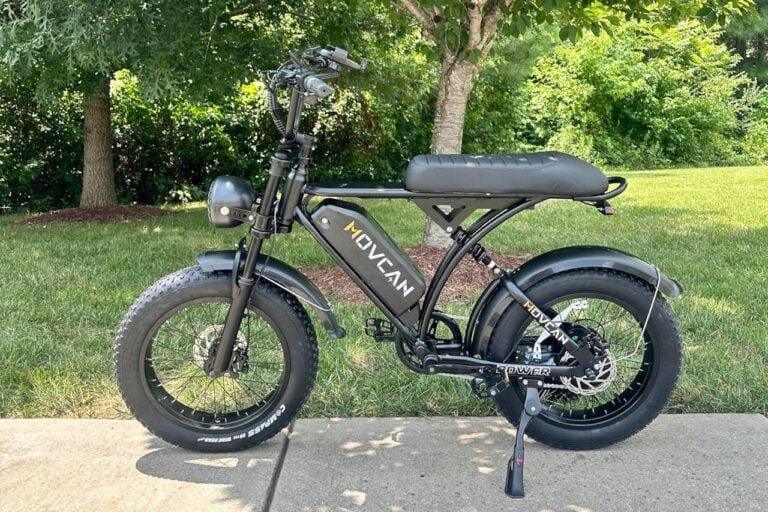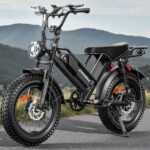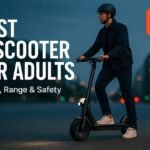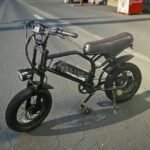![10 Best Foldable Electric Bikes for Adults in [year]: Power, Range & Comfort 10 Best Foldable Electric Bikes for Adults: Power, Range & Comfort](https://goebikelife.com/wp-content/uploads/2025/10/Best-Foldable-Electric-Bikes-for-Adults.jpg)
Folding e-bikes solve a wonderfully practical problem: you want real transportation power without giving up apartment space, elevator friendliness, or the ability to pop a bike into a car trunk or under a desk. When a folder is done right, it becomes your “anywhere bike”—easy to stash at home, at work, or on the go, yet capable enough for daily commuting, mixed-surface weekend rides, and errand duty.
This guide is designed to help you pick the right folding e-bike for how you actually ride. You’ll get a plain-English decision checklist, a quick comparison of ten popular models, clear “best for” picks, and hands-on advice about range, safety, maintenance, and accessories that matter. Everything is organized so you can skim, then dive deeper where it counts.
At-a-Glance Recommendations
- Best overall value (power + range + comfort): Cybervelo EK4 (and “EK4 Max” variants). A fat-tire folder with a big battery and confident road manners—ideal if you want a one-bike solution for pavement, rough city streets, and casual trail use.
- Best budget folder for city commuting: Gotrax R1. A sensible, lighter-feeling commuter with practical speed caps and straightforward daily usability.
- Best “range per dollar” pick: Bluebiko F6B. Listings commonly show larger 48 V battery options; a good choice if you prefer fewer charging stops and don’t mind extra weight.
- Best compact city folder: DTTZH A12. A small-wheel, small-footprint folder that’s easy to carry and store—great for short trips, elevators, and public transit.
- Best high-power off-road style folder: TT-EBIKE Folding Electric Bike (dual-motor variants). A heavy-duty machine that prioritizes torque and traction. Excellent on private land and rough tracks; overkill for many public bike paths.
- Best practical city utility build: isinwheel M40. City-leaning geometry and accessories (including basket on some trims) make daily errands simple.
- Best stable & easy option: Qlife Triker Electric Bike. A folding e-trike format for maximum stability, low-speed confidence, and utility riding.
- Also worth a look depending on region/availability: GOKEEP L20, INVANTI EB11, and Baicycle A02—all aimed at practical, value-minded riders who want cargo-friendly frames or a more upright, step-through stance.
A quick reality check: Amazon-style listings can vary by seller and region. Verify battery voltage and amp-hours, motor rating, speed limits, and warranty details before you buy. If possible, favor clearly stated electrical safety compliance, written after-sales support, and easy access to spares.
How to Choose a Folding E-Bike (Without Overthinking It)
Before you get buried in spec sheets, take two minutes to decide what matters most. Use this list as a conversation you have with yourself—answer honestly and the right bike will reveal itself.
1) Your real-world use
Rank these: city commute, hilly rides, mixed gravel, errands/cargo, off-road fun, train/bus folding, apartment carry. The more often you’ll lift or carry the bike, the more weight matters. The more you’ll ride on rough surfaces, the more fat tires and suspension help.
2) Legal class and speed
Most riders do best with Class 2 (up to ~20 mph with throttle and PAS) or Class 3 (up to ~28 mph with PAS, throttle rules vary) depending on local regulations. If you want to use bike paths and public transit without headaches, make sure the bike can be set (or locked) to the class you need. “30+ mph” marketing sounds fun; in practice it’s often meant for private property and may not play nicely with city infrastructure.
3) Battery and honest range
Battery size is expressed in watt-hours (Wh): simply multiply voltage × amp-hours (Ah). A typical mixed-assist adult ride consumes about 18–25 Wh per mile. Rough guide:
- 36 V 10 Ah (≈360 Wh): ~14–20 real miles
- 48 V 15 Ah (≈720 Wh): ~30–45 real miles
- 52 V 20 Ah (≈1,040 Wh): ~40–60+ real miles (terrain and speed matter!)
If you ride fast, carry weight, or climb hills, expect the lower end of those ranges.
4) Weight and portability
Fat-tire folders with big batteries can weigh 65–85 lb. Compact city folders can be 45–60 lb. If you’ll routinely carry the bike upstairs or lift it into a car, weight is not “just a number”—it’s the difference between a bike you love and a bike you avoid.
5) Tires and braking
- 20×4.0 in fat tires: comfort, stability, curb-forgiveness. Heavy, more drag.
- 20×3.0–2.4 in: lighter, quicker steering, better for nimble city rides.
- 26×1.95 in: rolls fast and feels like a standard city/trekking bike once unfolded.
- Hydraulic discs: strongly preferred for heavier folders or higher speeds. Mechanical discs are okay on lighter, slower bikes.
6) Fit and ergonomics
Look beyond “fits riders from 5’2″ to 6’2″.” The variables that actually matter are standover height, seatpost travel, handlebar height adjustment, and reach. Step-through frames fit a wider range of riders and make start/stop traffic easier.
7) Folding mechanism and latch quality
Most use a mid-frame hinge plus a folding stem. Two things matter:
- A secondary safety (so a single failed latch never causes a frame fold while riding).
- Catch points or magnets to keep the bike halves together when carried.
8) Warranty, spares, and safety
Prefer bikes with a clear written warranty, accessible customer support, and standardized parts (brake pads, chains, tires, tubes). If a listing references electrical safety compliance, even better. For the battery, look for a well-specified BMS and clarity around charger specs.
Quick Comparison (Claimed/Typical Configurations)
Note: specs vary by listing and region. Use this as a starting point to compare intent and personality of each bike.
| Model | Wheel/Tire Format | Typical Motor Class | Typical Battery Options | Character | Who It Suits |
|---|---|---|---|---|---|
| Cybervelo EK4 (incl. “Max”) | 20×4.0 fat | High-torque hub (often marketed ~1,000 W class) | 48 V with larger Ah options | Do-most-things fat-tire folder with real range | Adults wanting one bike for city + rough surfaces |
| Bluebiko F6B | 20×4.0 fat | Mid/high-power hub marketing | 48 V with big-Ah choices | Long-range value angle | Riders who hate charging often |
| GOKEEP L20 | 20×3.0–4.0 | Mid-power hub (value focus) | 48–52 V options appear across listings | Utility step-through vibe | Everyday mixed-use riders |
| Gotrax R1 | 20 in city | ~500 W class commuter | 48 V midsize capacities | Lightweight-feeling city commuter | Budget-minded riders prioritizing practicality |
| Qlife Triker | 20 in trike | Utility-tuned hub | Moderate Wh packs | Stable, easy, cargo-friendly | Newer riders, errands, balance-first users |
| isinwheel M40 | 26×1.95 city | ~500 W commuter | Around mid-capacity | Efficient, easy-rolling city setup | Paved paths, baskets, errands |
| DTTZH A12 | 14 in compact | Zippy small-wheel hub | 48 V options on some listings | Ultra-portable, quick-fold | Train/bus, elevators, small storage |
| TT-EBIKE (dual-motor) | 26×4.0 fat | Dual-hub high-power | High-voltage/high-Ah | Off-road muscle machine | Private-land fun, steep tracks |
| INVANTI EB11 | 20×3.0 | Mid-power hub | ~500 Wh class common | Commuter/cargo crossover | City riders and light load carriers |
| Baicycle A02 | 20×4.0 fat | ~750 W rated/peaky | ≈750 Wh class common | Cargo-leaning fat-tire folder | Utility and value shoppers |
The Bikes: Mini-Reviews (What Each Is Really Like)
1) Cybervelo EK4 (incl. “EK4 Max”) — Best overall value
Why it’s compelling: This is the archetype of a modern fat-tire folder: confident stance, generous battery options, and a motor/controller setup that feels adult-friendly rather than toy-like. On bumpy urban streets, 20×4.0 tires combined with a sturdy frame make potholes and road seams less of a drama. It’s the kind of folder that “rides big” once unfolded and turns into a comfortable daily commuter that still has range in reserve for weekend exploring.
Where it shines
- Mixed pavement and rough city routes where the extra tire volume pays dividends.
- Riders who want fewer charging sessions.
- Taller riders who appreciate a roomy cockpit on a folder.
What to watch
- Weight. You’ll want a loading ramp or help if you lift it regularly.
- If your city enforces strict speed classes, make sure the settings adhere to your local cap.
Bottom line: An easy top recommendation for adults who want a single folding e-bike that does nearly everything well.
2) Gotrax R1 — Best budget city folder
Why it’s compelling: The R1 plays the “do the simple things right” card. It rides like a straightforward Class-2 commuter: practical top-speed behavior for bike paths and campus corridors, reasonable weight for a folder, and controls that won’t overwhelm first-time e-bike owners. If your priorities are predictable handling, painless daily use, and a price that leaves room for lights, a lock, and panniers, this is it.
Where it shines
- Daily short-to-medium commutes at responsible speeds.
- Apartment buildings where you’ll be folding and stashing frequently.
- Riders who prefer a calmer, lighter-feeling folder over a heavy fat-tire tank.
What to watch
- Battery capacity is positioned for commuters, not long-distance exploration.
- Less plush than 4-inch fat tires over really rough surfaces.
Bottom line: A sensible pick that respects local rules, your back, and your budget.
3) Bluebiko F6B — Budget long-range champion
Why it’s compelling: Listings commonly show bigger-Ah batteries here, which is the clever move for riders who’d rather ride than charge. Add in fat-tire comfort, and you get a setup that suits long errand loops or weekend city-to-trail transitions. If your routes include long straight sections at steady speed, that extra Wh buffer makes day-to-day life nicer.
Where it shines
- Riders who routinely cover 25–40 miles in a day.
- Folks commuting several days in a row without overnight charging.
- Heavier riders who appreciate more battery headroom.
What to watch
- Larger batteries add weight; plan for storage and lifting.
- As with many marketplace brands, confirm the exact battery/charger pairing and warranty details.
Bottom line: If range per dollar is your main metric, this is a very strong value play.
4) DTTZH A12 — Compact city expert
Why it’s compelling: Small wheels, small footprint, big convenience. The A12 focuses on portability and quick folding without feeling flimsy. For riders who weave through city blocks, hop onto trains, and tuck a bike under a desk, small-wheel folders reduce friction. With sensible gearing and a decent controller tune, they feel lively up to city speeds.
Where it shines
- Elevator-and-office workflows where quick fold/unfold matters.
- Car trunks that won’t accept a fat-tire 20-inch folder.
- Short hops where ultralight handling trumps ultimate comfort.
What to watch
- Small wheels are chattier over bad pavement—scan for potholes.
- At high assist, cadence can spin out; ride it like a nimble city tool, not a highway cruiser.
Bottom line: If portability is the hill you die on, choose a compact folder like this and never look back.
5) TT-EBIKE Folding Electric Bike (dual-motor variants) — Muscle machine
Why it’s compelling: Two motors, high voltage, high capacity—this is the off-road-leaning bruiser of the folding world. Think sand, snow, steep dirt paths, and private-property shenanigans. It’s not for everyone, and that’s the point. Many riders want calm daily transport; some want a torque monster that laughs at gradients. This one’s the latter.
Where it shines
- Private-land riding, steep tracks, and soft-surface traction.
- Heavier riders and/or cargo in rough conditions.
- Areas where high-speed throttled riding is allowed and appropriate.
What to watch
- Weight and size—transport and storage need a plan.
- Often not compliant for bike-path speed rules. Know your local regulations.
Bottom line: Overbuilt and proud of it. If you need power and traction above all else, few folders will touch it.
6) isinwheel M40 — Practical city comfort
Why it’s compelling: Some riders don’t want fat tires; they want practicality and efficiency. The M40 leans into that city-trekking personality with narrower 26-inch tires that roll easily, a comfortable upright stance, and useful accessories (like a basket on certain trims). It’s engineered for paved paths, campus routes, and grocery runs, not for plowing through beach sand.
Where it shines
- Paved commutes and errand loops.
- Riders who prefer a natural pedaling feel and easier rolling resistance.
- Those who want a bike that “feels normal” the moment you start pedaling.
What to watch
- Folding size is larger than a 20-inch bike; check storage measurements.
- Battery capacity suits daily use but isn’t built for ultra-long adventures.
Bottom line: A city-first folder that behaves like a sensible commuter once unfolded.
7) Qlife Triker Electric Bike — Stable & easy
Why it’s compelling: Not everyone loves balancing a two-wheeler at low speed, especially with cargo. A folding e-trike solves that with a stable footprint, accessible step-through design, and a ride style that puts “easy” first. Speeds are typically lower, which pairs well with errands and neighborhood routes.
Where it shines
- Grocery runs and utility riding with a relaxed pace.
- Riders who value stability or have balance considerations.
- Campgrounds, retirement communities, and neighborhood loops.
What to watch
- Trikes don’t lean—corner more slowly and brake earlier.
- Folding/transport is more involved; measure the folded dimensions carefully.
Bottom line: If you want “no drama” stability and utility at mellow speeds, the trike format is a joy.
8) INVANTI EB11 — Commuter/cargo crossover
Why it’s compelling: This one sits in the practical middle: a moderate-power hub motor, commonly seen ~500 Wh batteries, and 20×3.0 tires that split the difference between agility and comfort. A good fit for urban riders who want a trustworthy commuter that can carry a bit of extra load without needing fat-tire heft.
Where it shines
- City riders with mixed pavement quality.
- Light cargo duties: panniers, backpacks, and small baskets.
- Riders who want “enough” battery without a weight penalty.
What to watch
- Availability and configs vary by region; confirm battery size and included accessories.
Bottom line: A neat all-rounder that doesn’t chase extremes—easy to recommend for general commuting.
9) Baicycle A02 — Cargo-leaning fat-tire folder
Why it’s compelling: Think racks, baskets, and a frame that welcomes accessories. The A02 pushes a utilitarian angle with fat-tire comfort and battery capacities that make daily duty realistic. If you’re hauling groceries, gym gear, or a laptop bag across rough city streets, the combination of volume tires and cargo friendliness makes life easier.
Where it shines
- Errands and multi-stop routes on imperfect pavement.
- Riders who want the comfort of fat tires with a practical utility frame.
- Those who value a stable platform for a child seat or rear basket (check mounts and weight limits).
What to watch
- Heavier than slim-tire city folders; plan your storage and lifting technique.
- Confirm included racks and exact cargo ratings before purchase.
Bottom line: A value-oriented utility folder that embraces the “mini-cargo” mindset.
10) GOKEEP L20 — Value-minded step-through
Why it’s compelling: The L20 plays in the widely popular step-through, fat-tire folding category. If you like an easy mount/dismount, upright posture, and a confident stance on mixed surfaces, this shape makes sense. Listings sometimes reference higher-voltage systems that give zippy acceleration and better hill starts—an appealing trait for stop-and-go city riding.
Where it shines
- Riders who want approachable ergonomics and confidence at low speed.
- City routes with frequent lights and stop signs.
- A “one bike for everything” mindset on a value budget.
What to watch
- Check exact battery/motor options and ensure the class/speed can be configured to local rules.
Bottom line: A friendly, do-it-all step-through folder that fits a wide range of riders and use cases.
Real-World Range, Explained (So You Don’t Get Surprised)
There’s a huge difference between marketing range and your range. The honest calculation:
- Convert to Wh: Voltage × amp-hours.
- Estimate consumption: Most adult riders on mixed terrain use 18–25 Wh/mile.
- Divide: Wh ÷ (your Wh/mile) = your range.
Examples
- 48 V × 15 Ah = 720 Wh.
- Conservative rider at 18 Wh/mile → ~40 miles
- Faster rider at 25 Wh/mile → ~28–29 miles
- 52 V × 20 Ah = 1,040 Wh.
- Conservative 18 Wh/mile → ~57–58 miles
- Faster 25 Wh/mile → ~41–42 miles
Factors that cut range: cold weather, headwinds, hills, heavy cargo, high PAS levels, frequent throttle use, under-inflated tires.
Factors that boost range: steady cadence, moderate PAS (2–3), tire pressures appropriate for your surface, and a well-lubed drivetrain.
Safety & Compliance (Boring, But Important)
- Class & speed limits: If you rely on bike paths, transit, or shared spaces, choose a bike that can be configured to your permitted class (often Class 2 or Class 3).
- Brakes: Heavier bikes at higher speeds need hydraulic discs and quality rotors. Consider a bed-in procedure for new pads.
- Battery care: Charge with the included charger on a non-flammable surface in a ventilated area. Avoid storing the pack fully charged or fully empty for long periods; 50–80% is ideal for storage.
- Hinge safety: Keep the folding latch clean and verify secondary safeties are engaged before riding.
- Lighting & visibility: Stock lights are a start. Add a bright daytime-visible headlight and a high-mount rear flasher; reflective sidewalls or spoke reflectors help in city traffic.
Setup & Maintenance: The 30-Minute Routine
Day 1 (unboxing):
- Torque check the stem, handlebar clamp, pedals, caliper bolts, rotor bolts, crank bolts, and rack mounts.
- Align the front wheel properly in the fork; ensure the quick-release or thru-axle is secure.
- Adjust the derailleur and confirm the limit screws (no chain derails on the first ride).
- Bed-in brakes: 15–20 controlled near-stops from ~15–20 mph.
Week 1:
- Re-check torque on hinge hardware and cockpit fasteners.
- Confirm the latch detent is free of grit and the safety is easy to engage.
- Assess saddle height and handlebar reach after two or three rides; small tweaks make a big comfort difference.
Monthly:
- Lube chain; wipe drivetrain.
- Inspect pads and rotors; replace pads before they’re paper-thin.
- Check tires for cuts and embedded debris; top up pressure.
- Quick check for loose spokes (ping test) and wheel true.
Seasonally:
- Inspect cables/hydraulic lines for rub points.
- Update any display/controller settings you’ve outgrown (e.g., start assist, PAS levels).
- If storing the bike for a while, top battery to ~60% and check it monthly.
Accessories That Actually Help (and Don’t Just Add Weight)
- Mirror: Bar-end or clamp-on. Makes urban riding calmer.
- Lock: A compact U-lock or a rated folding lock; consider a secondary cable for wheels.
- Rack + basket/panniers: For folders with utility frames (Baicycle A02 style), cargo add-ons pay off immediately.
- Pump & gauge: Tire pressure controls comfort, range, and puncture risk.
- Spare tubes & levers: Especially for 20×4.0 fat tires; they’re not always on hand at every shop.
- Helmet with rotational protection: Keeps you riding tomorrow.
Sizing & Fit (Don’t Skip This)
Two riders of the same height can have very different inseams and arm lengths. On a folder, micro-adjustability is your friend:
- Seatpost: You should achieve a comfortable knee bend at full pedal extension (not locked out).
- Stem/handlebar: Adjust to remove wrist strain and keep shoulders relaxed.
- Reach: On fat-tire folders that “ride big,” consider a shorter stem or swept-back bar if you feel stretched.
- Pedals & saddle: Cheap upgrades that transform comfort for long rides.
If you’re between sizes or worried about fit, a step-through layout plus a long-travel seatpost is the most forgiving combo for households with multiple riders.
Common Use Cases (and the Best Bike Types for Each)
1) Apartment + subway commute
- What matters: low weight, quick fold, stable latch, clean tires/fenders.
- Good picks: Gotrax R1, DTTZH A12.
- Pro tip: practice the fold at home; your first attempt shouldn’t be at a crowded station.
2) Mixed city + terrible pavement
- What matters: fat tires, sturdy racks, hydraulic brakes.
- Good picks: Cybervelo EK4, Baicycle A02.
3) Long suburban rides
- What matters: battery capacity, efficient pace, comfortable cockpit.
- Good picks: Bluebiko F6B, Cybervelo EK4.
4) Stability first
- What matters: low speed control, easy mounts, cargo readiness.
- Good picks: Qlife Triker.
5) Off-road private-property fun
- What matters: traction, torque, durability, controller cooling.
- Good picks: TT-EBIKE (dual-motor).
6) Paved city + errands
- What matters: lighter rolling tires, rack/basket, intuitive controls.
- Good picks: isinwheel M40, INVANTI EB11.
Troubleshooting (Because Real Life Happens)
- Bike veers or feels “hinged” mid-turn → Check that the frame latch is fully engaged with its secondary safety. Inspect hinge play; adjust hardware if the manual allows, or contact support.
- Range suddenly drops → Cold weather, low pressure, or a dragging brake are the top three culprits. Inflate tires, check rotor rub, and try a conservative PAS level to verify.
- Noisy shifting → Re-index the rear derailleur and check the chain for stiff links; lube fixes most chatter.
- Squealing brakes → Bed them in again; clean rotors with isopropyl alcohol and use fresh pads if contaminated.
- Wobbly steering → Confirm the stem latch is tight, headset preload is correct, and the handlebar clamp is torqued.
FAQ
Q: Can I bring a folding e-bike on trains and buses?
A: Often yes, but folded dimensions and battery policies vary. Compact 14–20-inch folders are generally easier than 26-inch models. When in doubt, remove the battery and keep the bike clean (no greasy chain imprint on your pant leg).
Q: How fast should a folding e-bike go?
A: For city use, Class-2 (≈20 mph) or Class-3 (≈28 mph PAS) is plenty. Higher speeds reduce range and can complicate legal use on public paths. The safest “fast” is smooth, predictable riding at the same speed as surrounding cyclists.
Q: Are fat tires worth the weight?
A: If your routes include broken pavement, curbs, or light trails, yes—comfort and confidence are real. If you’re on clean bike lanes and carry your bike often, slimmer tires save weight and energy.
Q: What tire pressures should I run?
A: As a starting point for adults:
- 26×1.95: 45–60 psi depending on rider weight and comfort.
Adjust up or down after a test ride—the right pressure is the one that feels planted without bouncing. - 20×4.0 fat tires: 18–24 psi pavement, 14–18 psi rough mixed surfaces.
- 20×3.0: 28–32 psi pavement.
Q: How should I store the battery?
A: If not riding for a while, leave it around 50–80%, store in a cool, dry place, and top it up monthly. Avoid leaving it at 100% or below 10% for long periods.
Q: Hydraulic or mechanical brakes?
A: On fat-tire 65–85 lb folders, hydraulics are worth it. They deliver consistent stopping with less hand effort and better modulation.
Q: What about water resistance?
A: Most folders are built for light rain, not pressure washers. Dry the bike after wet rides, and keep the hinge and latch clean.
The Bottom Line
If you want a single folding e-bike that feels confident on city streets, shrugs off rough pavement, and offers real-world range, the Cybervelo EK4 is the most balanced pick in this lineup. It’s the “adult choice” for riders who want power, comfort, and fewer charging breaks.
If your priorities are budget, portability, and an easy daily commute, choose the Gotrax R1. It respects local speed norms, feels lighter on its feet, and keeps maintenance simple.
If you’re chasing maximum miles between plug-ins, the Bluebiko F6B is your range-per-dollar hero—just acknowledge the weight trade-off and confirm the exact battery configuration before you order.
Prefer stable or cargo-first riding? The Qlife Triker and Baicycle A02 lean into utility, while the isinwheel M40 offers a practical city kit that rolls easily and carries what you need without drama.
And if your playground is private property and you want to conquer sand, snow, and steep tracks, the TT-EBIKE dual-motor variant is unapologetically overbuilt for the job.
Choose based on your reality—where you ride, how far you go, how often you’ll lift the bike, and the rules in your area. Do that, and any of the ten models here can serve you well, transforming daily travel from a chore into the best part of your day.


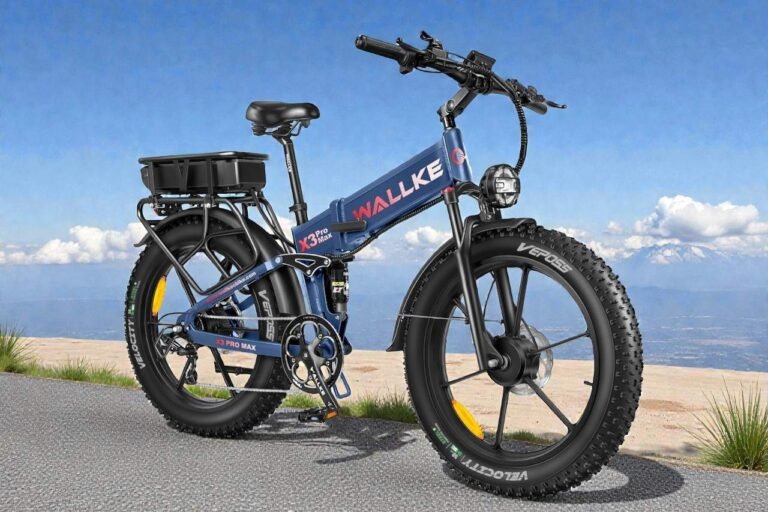
![Is the Heybike Cityscape 2.0 the Best Budget Commuter in [year]? Heybike Cityscape 2.0 Electric Bike Review](https://goebikelife.com/wp-content/uploads/2025/05/Heybike-Cityscape-2.0-Electric-Bike-Review-768x512.jpg)
